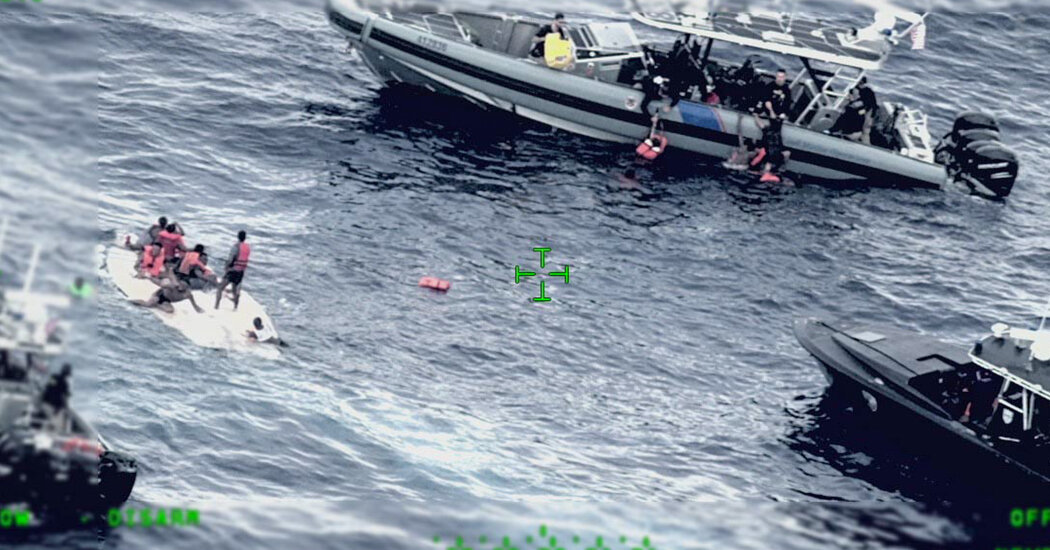
[ad_1]
At least 11 people died and 31 others were rescued on Thursday after a boat carrying migrants capsized about 10 miles north of Deseceo Island, PR, the US Coast Guard said.
The agency said that the crew of a Customs and Border Protection aircraft sighted a capsized vessel shortly before noon. The crew reported people in the water who did not appear to be wearing life jackets, the Coast Guard said.
The Coast Guard said the vessel was “suspected of taking part in an illegal voyage.”
Most of the people on the boat were from Haiti, but two of the survivors were from the Dominican Republic, said Jeffrey Quiñones, a spokesman for US Customs and Border Protection. The boat set off from the Dominican Republic and was en route across the treacherous Mona Passage to the western side of Puerto Rico, he said.
Mr. Quiñones said that, based on accounts from the migrants, the boat was taking on water and the occupants were trying to shovel water from the boat. He said this was not uncommon for such voyages because the boats are often “unseaworthy.”
“It appears that the boat broke because it’s not a boat that’s made for such a voyage,” Mr. Quiñones said. “With a lot of people inside the boat, of course this could happen.”
A Coast Guard spokesman said Thursday night that the agency was still searching for survivors and did not know how many people had been on the boat. The search was expected to continue through the night.
The top priority is saving lives, Rear Adm. Brendan C. McPherson of the Coast Guard said in a statement. “We are searching for survivors with all available assets, including helicopters, airplanes, and rescue boats from the US Coast Guard, Customs and Border Protection Air and Marine Operations, and Puerto Rico Joint Forces of Rapid Response partners,” he said.
A lack of opportunity in developing countries, which were hard hit by the coronavirus pandemic and rising prices that have caused food insecurity, has propelled growing numbers of people to seek entry into the United States.
More than 3,200 migrants were apprehended while trying to reach the United States by sea during the 2021 fiscal year. Most of those apprehensions took place in California, but the authorities in Florida detained 1,316 Cubans, Haitians and Dominicans, almost as many as the two previous fiscal years combined.
The data undercounts the true number of people seeking entry by sea because it represents only events in which people are detained or a vessel is recovered.
After the Border Patrol and other law enforcement agencies apprehended five smugglers and 25 migrants from Haiti and the Dominican Republic off the coast of Puerto Rico last fall, officials noted an uptick in illegal activity.
“We are seeing an increase in smuggling attempts across our borders,” Xavier Morales, chief patrol agent for the Ramey Border Patrol Sector, said in a statement at the time.
Many of the migrants are coming from Haiti. They take treacherous routes to escape a country gripped by gang violence, political instability and widespread poverty. They arrive on the western coast of Puerto Rico with some frequency, often on makeshift wooden boats known on that island as “yolas.”
When federal authorities have apprehended large groups of migrants or arrested their smugglers, they have repeatedly emphasized the dangers of crossing the Mona Passage or making unsafe landings, either in western Puerto Rico or three small islands in the passage: Mona, Monito and Desecheo.
In October, the US Border Patrol arrested four Dominican men and charged them with transporting 43 Haitians to Mona Island.
Last week US Border Patrol agents apprehended 60 Haitian migrants and one Dominican woman who arrived in Cabo Rojo, in southwestern Puerto Rico. That followed the arrival this month of 59 Haitians in Rincón, on Puerto Rico’s northwestern tip, which is known for its strong surf.
In that case, agents had spotted the makeshift boat, a 30-foot homemade vessel, reaching the coast. They found it abandoned on shore and searched the area before finding the migrants, according to the Border Patrol.
Mr. Quiñones, the Border Patrol spokesman, said his agency had frequently discussed capsizings. In general, he said, smugglers use dangerous methods to avoid detection like covering the boat with a blue tarp or using a low-horsepower engine to minimize water splashing, with the treacherous consequence of prolonging the journey.
“These vessels and the conditions that the smugglers put these migrants in during the journey, it’s mind boggling,” he said.
Patricia Mazzei contributed reporting.
[ad_2]
Source link




